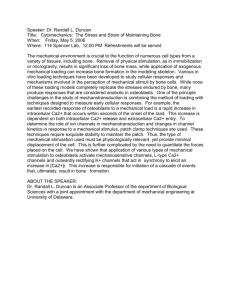28_Fridlyand\28_Fridlyand and Philipson Final
advertisement
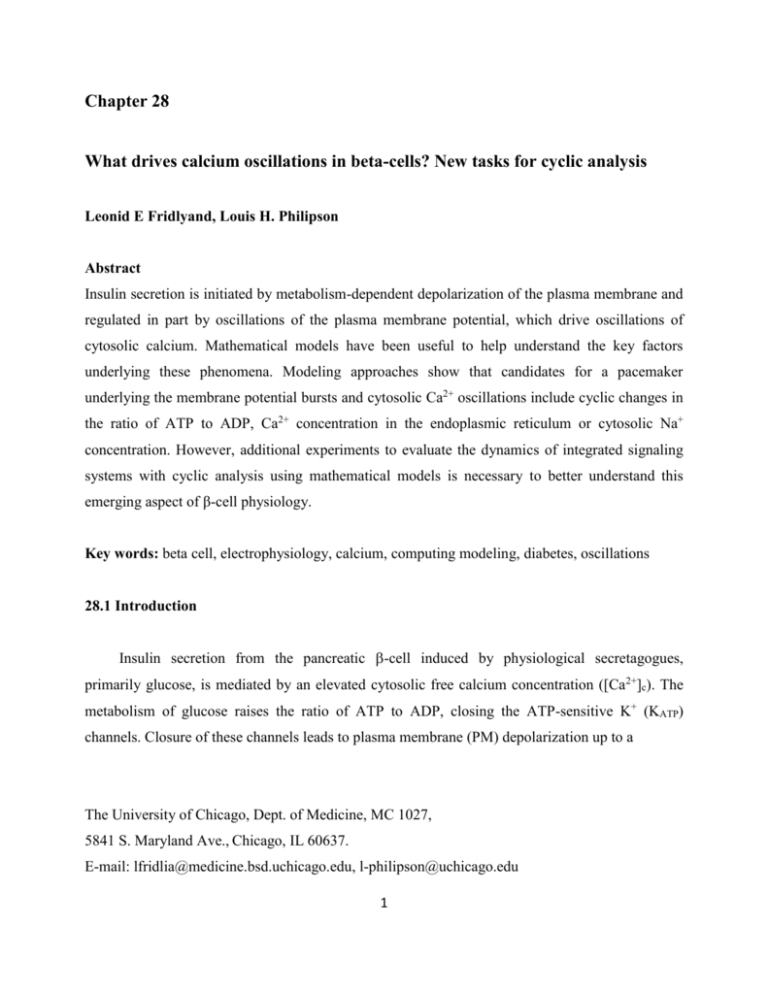
Chapter 28 What drives calcium oscillations in beta-cells? New tasks for cyclic analysis Leonid E Fridlyand, Louis H. Philipson Abstract Insulin secretion is initiated by metabolism-dependent depolarization of the plasma membrane and regulated in part by oscillations of the plasma membrane potential, which drive oscillations of cytosolic calcium. Mathematical models have been useful to help understand the key factors underlying these phenomena. Modeling approaches show that candidates for a pacemaker underlying the membrane potential bursts and cytosolic Ca2+ oscillations include cyclic changes in the ratio of ATP to ADP, Ca2+ concentration in the endoplasmic reticulum or cytosolic Na+ concentration. However, additional experiments to evaluate the dynamics of integrated signaling systems with cyclic analysis using mathematical models is necessary to better understand this emerging aspect of β-cell physiology. Key words: beta cell, electrophysiology, calcium, computing modeling, diabetes, oscillations 28.1 Introduction Insulin secretion from the pancreatic -cell induced by physiological secretagogues, primarily glucose, is mediated by an elevated cytosolic free calcium concentration ([Ca2+]c). The metabolism of glucose raises the ratio of ATP to ADP, closing the ATP-sensitive K+ (KATP) channels. Closure of these channels leads to plasma membrane (PM) depolarization up to a The University of Chicago, Dept. of Medicine, MC 1027, 5841 S. Maryland Ave., Chicago, IL 60637. E-mail: lfridlia@medicine.bsd.uchicago.edu, l-philipson@uchicago.edu 1 threshold potential where voltage-dependent Ca2+ channels (VDCC) located on the PM are activated. Ca2+ influx through VDCCs leads to an increased [Ca2+]c, which triggers the exocytosis of insulin-containing granules. There is an extensive literature describing β-cell electrical activity and its relationship to intracellular Ca2+ concentration in intact islets of Langerhans and isolated islet cells (for recent review see Jacobson and Philipson 2008; Henquin et al. 2009). Mechanisms of glucose-induced PM depolarization, cytosolic and mitochondrial processes were also considered in previous chapters. The β-cell membrane is hyperpolarized at resting potential at low glucose levels ( 3–5 mM) in islets. When glucose metabolism induces an increased potential across the membrane, a resultant electrical activity of the pancreatic -cell is usually organized into slow depolarizing waves, called bursting, with a plateau from which action potentials (AP) rapidly fire. They are separated by quiescent (resting) periods at potentials below the AP threshold. This bursting phenomenon regenerates as long as the glucose concentration is elevated and results from the metabolic processes and electrical activity of ion channels and pumps localized on the β-cell plama membrane (Ashcroft and Rorsman 1989, Jacobson and Philipson 2008). Rapid depolarization at the beginning of the burst and a repolarization at the end result in opening and closing of VDCCs. This leads to cytosolic Ca2+ oscillations which are synchronized with cyclical spike-burst activity in response to a rise in extracellular glucose (Jacobson and Philipson 2008, Henquin et al. 2009). These Ca2+ oscillations are intimately connected to multiple key aspects of β-cell physiology and their regulation continues to be an important area of study. Increased glucose concentration induces several types of cyclical spike-burst activity and Ca2+ oscillations in insulin secreting -cells with different periods (Beauvois et al. 2006, Bertram et al. 2008, Henquin et al. 2009). Oscillations with a period from several seconds to one minute are usually denoted as “fast.” Ca2+ oscillations with a period ranging from 1 to several minutes and long bursts are designated as “slow”. Mixed (or compound) Ca2+ oscillations are characterized by fast oscillations superimposed on slow oscillations. This is due to periodic episodes of fast bursts, called compound bursting (Bertram et al. 2004, Beauvois et al. 2006). Fast electrical bursting and cytoplasmic Ca2+ oscillations are usually observed in isolated mouse islets. Slow and mixed cytoplasmic Ca2+ oscillations are observed both in islets, single cells and clusters of cells at stimulating glucose concentrations (Gilon et al. 2002, Bertram et al. 2004, Beauvois et al. 2006). 2 Various experimental and theoretical approaches support the idea that the AP bursts, when spike activity occurs, and the corresponding [Ca2+]c oscillations reflect a periodic depolarization of the plasma membrane (Ashcroft and Rorsman 1989, Beauvois et al. 2006, Fridlyand et al. 2009). A depolarizing component predominates at the beginning of the burst, but the resultant influx of Ca2+ during the burst leads to a progressive increase in outward and/or a decrease in inward cation currents leading to repolarization and burst termination. Slow depolarization in a resting (silent) phase should lead to burst re-initiation (Ashcroft and Rorsman 1989, Fridlyand et al. 2009, Henquin et al. 2009). After the large depolarizing effect of closing KATP channels, the subsequent generation and termination of the bursts may be determined by small cyclical changes of any plasma membrane current (Fridlyand et al. 2009). For this reason, initiation and termination of the bursts results from activation and deactivation of several electrogenic channels, pumps or exchangers which can be modulated in turn by numerous intracellular components. A variety of different proposals and corresponding mathematical models have been advanced underlining the nature of these components. In this chapter we discuss an analysis of the proposals to explain these phenomena, together with the underlying experimental data and the corresponding mathematical models. Bertram and Sherman (2005) have written a historical review on the development of mathematical modeling of β–cell oscillatory processes. For this reason we concentrated on recent developments in this field and new experimental evidence with the goal of understanding how bursting and [Ca2+]c oscillations can arise. Several illustrative examples are presented below. We consider here only models for individual β–cells that represent behavior of cells in electrically synchronized normal islets. Models that treat the effect of electrical coupling can also be found (see for example Benninger et al. 2008). Bursting and [Ca2+]c oscillations are easily obtainable phenomenon in isolated mouse islets. Oscillatory behavior can be changed by numerous hormones, small molecule agonists as well as toxins. The study of the changes in bursting or [Ca2+]c oscillations could yield a flexible systematic explanation for the action of different signaling molecules on pancreatic β-cells. However, this important approach requires a comprehensive knowledge of the pacemaker mechanisms of these oscillations. 3 Interestingly, the rhythmic variations in insulin secretion from islets are synchronized with oscillations of the cytoplasmic Ca2+ concentration (Henquin et al. 2009, Tengholm and Gylfe 2009). Whereas pulsatility appears to be a natural function of islets both in vivo and in vitro, it has been hypothesized that the disruptions in rhythmic function may be an early biomarker of islet dysfunction leading to diabetes (Tengholm and Gylfe 2009). This emphasizes also the need for careful study of these oscillatory processes. 28.2 Schematic model The main components that we consider in this chapter as important for generation of bursting and cytoplasmic Ca2+ oscillations are summarized in Fig. 28.1. The “complex model” of processes (from Fridlyand et al. 2003) was used for the following simulations. This model is available for direct simulation on the website “Virtual Cell” (www.nrcam.uchc.edu) in “MathModel Database” on the “math workspace” in the library “Fridlyand” with name “Chicago 1”. (Figure 28.1) The differential equation describing time-dependent changes in the plasma membrane potential (Vp) is the current balance equation: dVp Cm IVCa + ICapump + INaCa + ICRAC + INa + INaK + IKDr + IKCa + IKATP dt (28.1) where Cm is the whole cell membrane capacitance. The plasma membrane currents are listed in Figure 28.1. Equations for [Ca2+]c dynamics can be also written as in our model (Fridlyand et al. (2003)): d[Ca2+]c IVCa + 2INaCa - 2 I Capump Jout fi Jer,p + dt 2 F Vi Vi + ksg [Ca2+]c (28.2) where fi is the fraction of free Ca2+ in cytoplasm, F is Faraday’s constant, Vi is the effective volume of the cytosolic compartment, Jer,p is flux into the endoplasmic reticulum (ER) through 4 SERCA pumps per cytosol volume, Jout is a Ca2+ leak current from the ER per whole cell and ksg is a coefficient of the sequestration rate of [Ca2+]c. The voltage-dependent Ca2+ channel conducts Ca2+ ions into the cell, which raises the transmembrane voltage, Vp, whereas the K+ channel gates efflux of K+ and restores Vp to a low level. The temporal interaction of the two channels is sufficient to explain the repetitive spiking observed in β-cells (see Bertram and Sherman 2005, Fridlyand et al. 2009). However, an inclusion of additional components was necessary to explain a burst behavior. 28.3 [Ca2+]c as the pacemaker component Initially, a mechanism with a [Ca2+]c feedback effect was proposed to underlie generation of bursts and [Ca2+]c oscillations. According to this hypothesis Ca2+ influx during the active phase would cause a slow rise in [Ca2+]c, which activated Ca2+-activated K+ (KCa) channels (current IKCa in Eq. 28.1) that in turn repolarized the plasma membrane potential until a critical level was attained. This would shut down the spiking and inactivate VDCCs, leading to a resting phase. A slow decrease in [Ca2+]c levels in a resting period would lead to decreased current through KCa channels, reinitiating PM depolarization and of the start of a new burst. In this case a cyclical change in [Ca2+]c is a candidate for an islet pacemaker for burst behavior and [Ca2+]c oscillations per se (Atwater and al. 1979). For a description of mathematical models incorporating the cyclical activation and deactivation of KCa channels by bursting-induced elevations in [Ca2+]c see Bertram and Sherman (2005). One problem with this hypothesis is that [Ca2+]c should increase slowly during a burst period leading to a slow increase of current through KCa channels. However, subsequent Ca2+ imaging data indicates that that the time scale of the [Ca2+]c change is short relative to the oscillation period. For this and other reasons, this mechanism for [Ca2+]c oscillations was ruled out (see Bertram and Sherman 2005). 28.4 Role [ATP]/[ADP] ratio as pacemaker After the large inward currents of KATP channels are mostly inhibited following glucose metabolism, their small remaining conductance is still comparable with the conductance of other channels, exchangers and pumps (Smolen and Keizer 1992). KATP channel regulation can thus participate in the subsequent generation and termination of the bursts. Cyclical changes in the KATP 5 channel conductance were proposed as a mechanism underlying oscillatory behavior of β-cells (Smolen and Keizer 1992, Magnus and Keizer 1997, Rolland et al. 2002). One possibility is that the [ATP] to [ADP] ratio slowly decreases when [Ca2+]c increases during a burst, leading to a slow opening of the remainder KATP channels and PM repolarization. The opposite idea is that the [ATP]/[ADP] ratio gradually increases during a silent phase, when [Ca2+]c decreases, leading to further closure of KATP channels and plasma membrane depolarization. New bursts then are initiated when the plasma membrane depolarizes up to the threshold level (Magnus and Keizer 1997, Rolland et al. 2002). Indeed, the [ATP]/[ADP] ratio drops when [Ca2+]c rises and increases when [Ca2+]c falls (Detimary et al. 1998, Ainscow and Rutter 2002) indirectly supporting the proposal that [Ca2+]c oscillations can therefore evoke oscillations in [ATP]/[ADP] ratio and KATP channel conductance. Several mathematical models underlining the mechanisms of the [ATP]/[ADP] ratio changes and attendant [Ca2+]c oscillations were proposed, as follows. Empirical equations for [ATP]/[ADP] ratio changes were introduced by Smolen and Keizer (1992). In this formulation the [ATP]/[ADP] ratio decreases slowly with increased [Ca2+]c and increases with decreased [Ca2+]c in simulations using their empirical equation. Periodic changes in the [ATP]/[ADP] ratio and the corresponding KATP channel conductances, bursting and [Ca2+]c oscillations were simulated using this model. Several mechanistic hypotheses underlying the mechanism of how [Ca2+]c effects the [ATP]/[ADP] ratio were also proposed. A slow decrease in the [ATP]/[ADP] ratio with increased [Ca2+]c during bursts can result from either stimulation of ATP hydrolysis or inhibition of ATP production. [Ca2+]c activated ATP-consumption. Ca2+ activates Ca2+ pumps on the plasma membrane and in the endoplasmic reticulum (ER), as well as other intracellular reactions that use ATP. In these cases increased [Ca2+]c can increase ATP consumption and decrease the [ATP]/[ADP] ratio. An opposite process which increases the [ATP]/[ADP] ratio with decreased ATP consumption can occur with decreased [Ca2+]c (Rolland et al. 2002, Fridlyand et al. 2003). We illustrate this mechanism using a mathematical model (Fridlyand et al. 2003) that includes simulation of ATP consumption due to the work of Ca2+ pumps in the plasma membrane and ER as well as Ca2+activated ATP consumption in some cytosolic processes. The simulated phase relations are represented in Fig. 28.2 for the conditions when free ADP concentration in the cytoplasm (and the corresponding [ATP]/[ADP] ratio) is the main slow pacemaker parameter in this complex model. 6 In this case a fast rise in [Ca2+]c during the active phase leads to increased Ca2+-activated ATP consumption in the cytoplasm. Free ADP increases (and [ATP]/[ADP] ratio decreases) slowly, opening KATP channels. This in turn leads to a slow IKATP increase and plasma membrane repolarization, damping of potential spikes and then a corresponding decrease in [Ca2+]c. These processes have opposite directions after decreased [Ca2+]c in the silent phase. KCa channels serve to damp depolarization and terminate increased [Ca2+]c arising from the initial part of the active phase. (Figure 28.2) [Ca2+]c supressed ATP-consumption. An earlier proposal suggested that the uptake of Ca2+ by β– cell mitochondria suppressed the rate of production of ATP because Ca2+ decreased oxidative phosphorylation resulting in an energy-dissipative effect. This proposal also leads to a decreased [ATP]/[ADP] ratio with increased [Ca2+]c as in the first case. This allows the possibility of simulating [Ca2+]c oscillations through the cyclical changes in [ATP]/[ADP] ratio (Magnus and Keizer 1997). However, recent experimental data favors the opposite idea, as for example it was pointed out that “the primary role of mitochondrial Ca2+ is the stimulation of oxidative phosphorylation“ (Brookes et al. 2004). Hypotheses have been proposed to explain the mechanism of [ATP]/[ADP] ratio oscillations through glycolytic oscillations. This was suggested to occur by the positive feedback of the glycolytic enzyme phosphofructokinase product (fructose 1,6-bisphosphate) on phosphofructokinase activity and subsequent depletion of substrate (Tornheim 1997). Mathematical models were constructed based on this mechanism (Westermark and Lansner 2003, Bertram et al. 2004). However, an explanation of the slow [Ca2+]c oscillations on the basis of changes in KATP channel conductivity involves difficulties. According to this mechanism the conductance of the KATP channels should oscillate during bursting electrical activity following changes in the [ATP]/[ADP] ratio. However, KATP channel blockers such as sulfonylurea, which result in essentially complete IKATP block, do not stop bursting and slow Ca2+ oscillations. Sulfonylurea drug can even induce Ca2+ oscillations (Miura et al. 1997, Roe et al. 1998). Existence of slow [Ca2+]c oscillations was also found in a knock-out mouse lacking functional KATP channels (Dufer 7 et al. 2004, Ravier et al. 2009). These results argue against an important role for dynamic changes in KATP channel conductivity and, consequently, in [ATP]/[ADP] ratios in the generation of slow Ca2+ oscillations. 28.5 ER Ca2+ as a pacemaker component The endoplasmic reticulum (ER) is a high-affinity and high-capacity organelle for calcium storage. The β-cell ER sequesters Ca2+ when the cytosolic Ca2+ level is high and releases it when [Ca2+]c is low. Ca2+ enters the ER via P-type ATPases (SERCA pumps, primarily SERCA2/3 in β-cells) using ATP and exits through two ER Ca2+ channels: the inositol 1,4,5 triphosphate receptorchannels (IP3R) and the ryanodine receptor-channels (Fig. 28.1) (Gilon et al. 1999, Maechler et al. 1999, Tengholm et al. 1999, Arredouani et al. 2002). The ER influences Ca2+ dynamics in many cell types. The ER can play an important role in creating Ca2+ oscillations through activation of IP3R on ER membranes (Berridge et al. 2009). Several mathematical models were made underlining this mechanism for different, usually electrically unexcitable types of cells, resulting in Ca2+ oscillations if the inositol 1,4,5 triphosphate concentration is in the correct range (Shuster et al. 2002, Berridge et al. 2009). However, β-cells are excitable cells and Ca2+ ion influx from the extracellular space through VDCCs and pumping by PM Ca2+pumps, along with internal sequestration in ER stores, are the principal regulators of cytoplasmic Ca2+ homeostasis in these cells (Arredouani et al. 2002, Fridlyand et al. 2003). In β-cells, depletion of intracellular Ca2+ stores activates a Ca2+-release activated current (CRAC) which represents an inward cation current leading to depolarization that potentiates glucose-induced Ca2+ influx through VDCCs (Worley et al. 1994, Bertram et al. 1995, Roe et al. 1998, Cruz-Cruz et al. 2005). This current represents Na+ influx through nonselective plasma membrane cation channels, which have been described in insulin secreting β-cells (Roe et al. 1998, Cruz-Cruz et al. 2005). Several mathematical models simulate bursting and corresponding [Ca2+]c oscillations on the basis of this effect. Empirical equations for activation of CRAC currents with decreased [Ca2+]ER were introduced by Bertram et al. (1995) and Chay (1997). CRAC currents increased with a decreased [Ca2+]ER and vice versa using these special empirical equations. Periodic changes of 8 [Ca2+]ER, bursting and [Ca2+]c oscillations were simulated in these models (see also Bertran and Sherman 2005). We have developed an equation where CRAC represents Na+ influx through some nonselective cation channels which open with decreased [Ca2+]ER (Fridlyand et al. 2003). The proposed mechanism is illustrated in Fig. 28.3. In this simulation a rapid [Ca2+]c increase at the beginning of the active phase led to increased Ca2+ pumping into the ER and slow [Ca2+]ER accumulation with corresponding closure of nonselective cation channels. This decreased inward Na+ current through these channels resulted in PM repolarization, a termination of spiking and a transition to a silent phase. [Ca2+]ER slowly decreases during a silent phase as a result of exit of Ca2+ from ER, leading to increased of nonselective cation channel conductance, increased inward Na+ current and PM depolarization. This resulted in subsequent activation of VDCC and a new burst. In this case [Ca2+]ER is a slow pacemaker component in the mechanism for [Ca2+]c oscillations. (Figure 28.3) However, an argument can be made against all [Ca2+]ER–dependent mechanisms for slow [Ca2+]c oscillations, since it seems to be at odds with data demonstrating that slow oscillations can persist in the presence of thapsigargin, the agent that blocks SERCA and empties the ER stores (Arredouani et al. 2002, Fridlyand et al. 2003) or in a SERCA 3 knock-out mouse (Beauvois et al. 2006). 28.6 Intracellular [Na+] as a slow component in a pacemaker mechanism Cytosolic Na+ concentration ([Na+]c) changes may play an important role in the generation of slow Ca2+ oscillations in β-cells (Grapengiesser 1998, Fridlyand et al. 2003). Several components can regulate Na+ dynamics in β-cells. The electrogenic Na+K+-ATPase extrudes three Na+ ions in exchange for two K+ ions for each molecule of ATP hydrolyzed generating a net outward flow of cations through the plasma membrane. This enzyme has high activity in all excitable cells, including pancreatic β-cells, since it maintains the high K+ concentration in the cytoplasm (Owada et al. 1999). Like most other cells, the β-cells are equipped with a Na+/Ca2+ exchanger, an electrogenic transporter located on the PM that couples the exchange of 3Na+ for 1 Ca2+ (Gall et al. 9 1999). A change of cytoplasmic Na+ concentration ([Na+]c) will lead to changes in the inward and outward currents and therefore in the PM potential. We proposed a mechanism where [Na+]c is a dynamic pacemaker variable that can govern bursts and slow [Ca2+]c oscillations even though KATP channels or CRAC do not change their activity (Fridlyand et al. 2003). Fig. 28.4 illustrates the proposed mechanism using our mathematical model that includes a description of Na+,K+-ATPase, Na+/Ca2+ exchanger and [Na+]c dynamics. The following mechanism was responsible for bursting and Ca2+ oscillations: increased [Ca2+]c during a burst period activates Na+ influx through Na+/Ca2+ exchangers. The resultant increase in intracellular [Na+]c leads to a slow increase of outward current through electrogenic Na+-K+ pumps (INaK in Figure 28.1) with corresponding plasma membrane repolarization, and reenters a silent phase. Decreased [Ca2+]c during a silent phase leads to a slow decrease in [Na+]c because Na+ influx through Na+/Ca2+ exchanger decreases. This leads to a decrease of outward current through electrogenic Na+-K+ pumps and then in turn to plasma membrane depolarization and an activation of a burst. A correlation of the model simulations with experimental data shows that the suggested mechanism with [Na+]c changes can explain bursting and slow [Ca2+]c oscillations (Fridlyand et al. 2003). However, this mechanism of oscillations remains incompletely studied. (Figure 28.4) 28.7 Mechaninistic interactions and compound patterns of bursting and [Ca2+]c oscillations Different [Ca2+]c oscillations can appear together in the compound (mixed) pattern (Beauvois et al. 2005, Bertram et al. 2008). The fact that the fast and slow modes of oscillation can occur together, as in the compound pattern, or separately, as in the fast and slow patterns, strongly argues that they stem from distinct mechanisms. These mechanisms can be reciprocally linked and are often co-occurring, but can also proceed largely independently of each other. Mixed oscillations also occur in isolated cells, suggesting that this peculiar pattern does not result from the sum of signals produced in distinct β-cells in islets (Gilon et al. 2002). Modeling approaches show that the compound behavior can be simulated and favors a scenario where two or more slow variables interact to produce complex oscillations. For example, Bertram et al. (2004) simulated the fast oscillations by small variations in KATP conductance using 10 an empirical equation connecting the [ATP]/[ADP] ratio with [Ca2+]c changes, whereas the slow [Ca2+]c oscillations were simulated as metabolic glycolytic oscillations. These two variables interact to produce compound oscillations, consisting of episodes of bursts separated by long periods of silence, or “accordion” oscillations, which consist of fast bursts with a slowly modulated duty cycle. Similar behavior could be achieved by defining the slow and fast variables in other ways (Bertram et al. 2008). For example, according to a recent mathematical model by Diederichs (2008), slow [Ca2+]c oscillations in the compound pattern may be a result of a [Ca2+]ER dependent mechanism while the KATP dependent mechanism may be responsible for fast [Ca2+]c oscillations superimposed on the top of the slow oscillations. 28.8 Summary The current mathematical models have great explanatory power. Modeling approaches show that cyclic changes in [ATP]/[ADP] ratio, concentration of Ca2+ in endoplasmic reticulum or cytoplasmic Na+ can be pacemakers for bursts and [Ca2+]c oscillations. However, some of the experimental data are contradictory and often do not support the existing models. Many of the mechanisms that can control β–cell electrical activity and Ca2+ handling have not been characterized. A complete identification of physiological variables that drive bursting or Ca2+ oscillations in β-cells and the underlying mechanisms remains elusive. Additional dynamic experiments and mathematical models are necessary to more fully understand this emerging aspect of β-cell physiology. Acknowledgments This work was supported in part by the NIH (R01 DK48494 to L.H.P.) and by The University of Chicago Diabetes Research and Training Center (P60 DK20595). 11 Reference list 1. Ainscow EK, Rutter GA. (2002) Glucose-stimulated oscillations in free cytosolic ATP concentration imaged in single islet beta-cells: evidence for a Ca2+-dependent mechanism. Diabetes 51 Suppl 1:S162-S170. 2. Arredouani A, Henquin JC, Gilon P (2002) Contribution of the endoplasmic reticulum to the glucose-induced [Ca2+]c response in mouse pancreatic islets. Am J Physiol Endocrinol Metab 282:E982-991 3. Atwater I, Dawson CM, Ribalet B et al (1979) Potassium permeability activated by intracellular calcium ion concentration in the pancreatic beta -cell. J Physiol 288:575588 4. Ashcroft FM, Rorsman P (1989) Electrophysiology of the pancreatic β -cell. Progress in Biophysics and Molecular Biology 54:87-143 5. Beauvois MC, Merezak C, Jonas JC et al (2006) Glucose -induced mixed [Ca2+]c oscillations in mouse beta-cells are controlled by the membrane potential and the SERCA3 Ca2+-ATPase of the endoplasmic reticulum. Am J Physiol Cell Physiol 290:C1503-1511 6. Berridge MJ (2009) Inositol trisphosphate and calcium signalling mechanisms. Biochim Biophys Acta 1793:933-940. 7. Benninger RK, Zhang M, Head WS et al (2008) Gap junction coupling and calcium waves in the pancreatic islet 95:5048-5061 8. Bertram R, Sherman A (2005) Negative calcium feedback: The road from ChayKeiser. In: Coombes, S., Bressloff, PC. (eds.) Bursting: the genesis of rhythm in the nervous system, pp.19-48. World Scientific, London 9. Bertram R, Rhoads J, Cimbora WP (2008) A phantom bursting mechanism for episodic bursting. Bull Math Biol 70:1979-1993 10. Bertram R, Satin L, Zhang M et al. (2004) Calcium and glycolysis mediate multiple bursting modes in pancreatic islets. Biophys J 87:3074 -3087 11. Bertram R, Smolen P, Sherman A et al (1995) A role for calcium release -activated current (CRAC) in cholinergic modulation of electrical activity in pancrea tic β-cells. Biophys J 68:2323-2332 12 12. Brookes PS, Yoon Y, Robotham JL et al (2004) Calcium, ATP, and ROS: a mitochondrial love-hate triangle. Am J Physiol Cell Physiol 287:C817-33. 13. Chay TR (1997) Effects of extracellular calcium on electrical bursting and intracellular and luminal calcium oscillations in insulin secreting pancreatic β -cells. Biophys J 73:1673-1688 14. Cruz-Cruz R, Salgado A, Sanchez-Soto C et al (2005) Thapsigargin-sensitive cationic current leads to membrane depolarization, calcium entry, and insulin secretion in rat pancreatic β-cells. Am J Physiol Endocrinol Metab 289:E439–E445 15. Detimary P, Gilon P, and Henquin JC. (1998) Interplay between cytoplasmic Ca2+ and the ATP/ADP ratio: a feedback control mechanism in mouse pancreatic islets. Biochem J 333:269274 16. Diederichs F (2008) Ion homeostasis and the functional roles of SERCA reactions in stimulus-secretion coupling of the pancreatic beta-cell: A mathematical simulation. Biophys Chem 134:119-143 17. Düfer M, Haspel D, Krippeit-Drews P et al (2004) Oscillations of membrane potential and cytosolic Ca2+ concentration in SUR1(-/-) beta cells. Diabetologia 47:488-498 18. Fridlyand LE, Jacobson DA, Kuznetsov A et al (2009) A model of action potentials and fast Ca2+ dynamics in pancreatic beta-cells. Biophys J. 96:3126-39. 19. Fridlyand LE, Tamarina N, Philipson LH (2003) Modeling of Ca2+ flux in pancreatic beta-cells: role of the plasma membrane and intracellular stores. Am J Physiol Endocrinol Metab 285:E138-E154 20. Gall D, Gromada J, Susa I et al (1999) Significance of Na/Ca exchange for Ca2+ buffering and electrical activity in mouse pancreatic β-cells. Biophys J 76:2018–2028 21. Gilon P, Ravier MA, Jonas JC (2002) Control mechanisms of the oscillations of insulin secretion in vitro and in vivo. Diabetes 51:S144-S151 22. Grapengiesser E. 1998. Unmasking of a periodic Na+ entry in glucose -stimulated pancreatic -cells after partial inhibition of the Na/K pump. Endocrinology 139:3227 – 3231 23. Henquin JC, Nenquin M, Ravier MA et al (2009) Shortcomings of current models of glucose-induced insulin secretion. Diabetes Obes Metab 11(s4):168-179 13 24. Jacobson DA, Philipson LH (2008). Ion Channels and Insulin secretion. In: Seino S, Bell GI (eds) Pancreatic Beta Cell in Health and Disease, pp. 91 - 110. Springer, Japan 25. Magnus G, Keizer J (1997) Minimal model of beta-cell mitochondrial Ca2+ handling. Am J Physiol 273:C717-733 26. Maechler P, Kennedy ED, Sebö E et al. (1999) Secretagogues modulate the calcium concentration in the endoplasmic reticulum of insulin-secreting cells. Studies in aequorin-expressing intact and permeabilized ins-1 cells. J Biol Chem 30:1258312592 27. Miura Y, Henquin JC, Gilon P (1997) Emptying of intracellular Ca2+ stores stimulates Ca2+ entry in mouse pancreatic beta-cells by both direct and indirect mechanisms. J Physiol 503:387-398 28. Owada S, Larsson O, Arkhammar P et al (1999) Glucose decreases Na+,K+-ATPase activity in pancreatic beta-cells. An effect mediated via Ca2+-independent phospholipase A2 and protein kinase C-dependent phosphorylation of the alphasubunit. J Biol Chem. 274:2000-2008 29. Ravier MA, Nenquin M, Miki T et al (2009) Glucose controls cytosolic Ca2+ and insulin secretion in mouse islets lacking ATP-sensitive K+ channels owing to a knockout of the pore-forming subunit Kir6.2. Endocrinology 150:33-45 30. Roe MW, Worley JF 3rd, Qian F et al (1998) Characterization of a Ca2+ releaseactivated nonselective cation current regulating membrane potential and [Ca2+]i oscillations in transgenically derived β-cells. J Biol Chem 273:10402-10410 31. Rolland JF, Henquin JC, Gilon P (2002) Feedback control of the ATP-sensitive K+ current by cytosolic Ca2+ contributes to oscillations of the membrane potential in pancreatic β-cells. Diabetes 51:376-84 32. Schuster S, Marhl M, Höfer T (2002) Modelling of simple and complex calcium oscillations. From single-cell responses to intercellular signalling. Eur J Biochem 269:1333-1355 33. Smolen P, Keizer J (1992) Slow voltage inactivation of Ca2+ currents and bursting mechanisms for the mouse pancreatic -cell. J Membr Biol 127:9-19 34. Tengholm A, Gylfe E (2009) Oscillatory control of insulin secretion. Mol Cell Endocrinol 297:58-72 14 35. Tengholm A, Hellman B, Gylfe E (1999) Glucose regulation of free Ca(2+) in the endoplasmic reticulum of mouse pancreatic beta cells. J Biol Chem 274:36883-36890. 36. Tornheim K (1997) Are metabolic oscillations responsible for normal oscillatory insulin secretion? Diabetes 46: 1375–1380 37. Westermark PO, Lansner A (2003) A model of phosphofructokinase and glycolytic oscillations in the pancreatic β-cell. Biophys J 85:126–139 38. Worley JF III, McIntyre MS, Spencer B et al (1994) Endoplasmic reticulum calcium store regulates membrane potential in mouse islet β -cells. J Biol Chem 269:1435914362 15 List of abbreviations AP, action potentials [Ca2+]c, free calcium concentration [Ca2+]ER, free calcium concentration in ER CRAC, Ca2+ -release activated current ER, endoplasmic reticulum IP3R, inositol 1,4,5 triphosphate receptor-channels KATP, ATP-sensitive K+ channels KCa, Ca2+-activated K+ channels PM, plasma membrane VDCC, voltage-dependent Ca2+ channels 16 Figure legends Figure 28.1. General scheme of the main processes involved in bursting and intracellular Ca2+ oscillations in pancreatic β-cells. Top: plasma membrane currents: voltage-dependent Ca2+ current (IVCa), a calcium pump current (ICapump), Na+/Ca2+ exchange current (INaCa), Ca2+ release-activated current (ICRAC); inward Na+ currents (INa); a sodium-potassium pump current (INaK), a delayed rectifying K+ current (IKDr), the small conductance Ca2+-activated K+ current (IKCa), ATP-sensitive K+ current (IKATP). ksg is a coefficient of the sequestration rate of Ca2+ by the secretory granules, SERCA is a calcium pump in the ER, Ca2+ leaks from ER through the IP3 receptor (IP3R). “ATP” is the free cytosolic form of ATP, ADPf is the free cytosolic form of ADP. Signals originating from fuel metabolism increase cytosolic calcium. Figure 28.2. Slow ATP/ADP ratio changes as a pacemaker. Burst behavior and the oscillation patterns are illustrated. It was simulated using model (Fridlyand et al. 2003) for conditions when changes in ATP/ADP ratio and corresponding IKATP are main component determining the membrane potential cyclic variations by setting: gmCRAN = 2. pS-1 mV, gmKATP = 70,000 pS, gmKCa = 150 pS, gmVCa = 1000 pS, kADP = 0.001 ms, kATP = 0.00002 ms, kATP,Ca = 0.00001 µM-1 ms-1, PCaER = 0.05 µM-1ms, PIP3 = 0.0004 pl-1 ms, PNaK = 80 fA. All other parameters setting are as in (Fig.3 and Tables from Fridlyand et al. 2003). (a) Action potential (Vp), (b) IKATP, (c) free [ADP] and (d) [Ca2+]c Figure 28.3. Slow [Ca2+]ER changes as a pacemaker. Simulations were made as in Figure. 28.2. Cyclic changes in [Ca2+]ER (and corresponding changes in ICRAN) is main slow parameter in mechanism of Ca2+ oscillations by setting: gmCRAN = 0.85 pS-1 mV, gmKATP = 10,000 pS, gmVCa = 600 pS, kADP = 0.0003 ms, PNaK = 200 fA. (a) Action potential (Vp), (b) ICRAC, (c) [Ca2+]ER and (d) [Ca2+]c. Figure 28.4. Slow [Na+]c changes as a pacemaker. Typical computer simulations were made as in Figure. 28.2. Slow bursting and the oscillation patterns of Ca2+ and Na+ are illustrated. Cyclic changes in [Na+]c (and corresponding changes in INaK) is main slow parameter in mechanism of Ca2+ oscillations by setting: kADP = 0.0003 ms, Pleuk = 0.0004 pl-1 ms, PNaK = 1000 fA. All other parameters setting are as in Fridlyand et al. (2003). (a) Action potential (Vp), (b) INaK, (c) free [Na+]c and (d) [Ca2+]c. 17
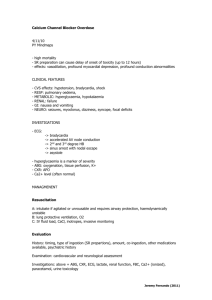
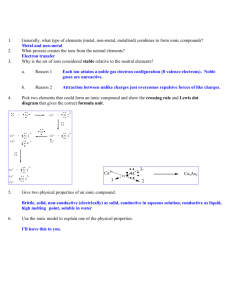
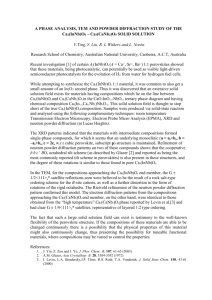
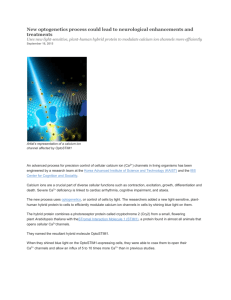
![Substantiation of the Rhod-2 as indicator of cytosolic [Ca2+] Rhod](http://s3.studylib.net/store/data/006893824_1-225923ad9f8cdb438dcdcf307ccbe9bd-300x300.png)

